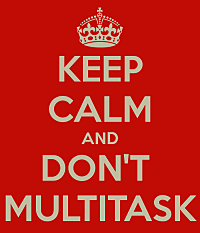 Multitasking makes you stoopid
Multitasking makes you stoopid
The neuroscience is clear, multitasking does not work. It is not a "skill" you can develop. It is not something you can possibly get good at. Multitasking is an urban myth in my opinion. In a healthcare setting, it can actually threaten patients' lives.
==========
Related:
Our Get Home Sooner Practice Efficiency Library
==========
The reason multitasking does not work is simple to explain
Your attention - the bandwidth of your awareness - is like a garden hose in a water fight.
If have only one target, it will receive the full flow of water. If you add in just one additional target, the flow is cut in half and each person receives only half the stream.
Like the water in the hose, there is a finite amount of your attention available at any one point in time.
- If you are doing one thing ... say reading an MRI report on one of your patients
- And you add in a second activity at the same time ... say pick up the phone and have a conversation while you continue to read the MRI report
- Your available attention for each individual activity has instantly been cut in half. You are now half as good at reviewing an MRI report -- and your phone conversation will have half the quality it would if that was the only thing you were doing.
- Your multitasking has allowed you to instantly do a half-assed job. Notice that this example has only two tasks. How many times have you tried to do three and four things at once. (is that then a 1/4 assed job?)
Unfortunately we are just getting started. You get the best results - and finish your task in the shortest amount of time - only when you focus on a single target at any given time.
In healthcare, where even little mistakes can have big consequences, multitasking is downright dangerous.
Here is a multitasking case study where mixing text messaging and online ordering resulted in a patient being taken to the O.R. for cardiac tamponade.
But what can you do when there simply ARE too many tasks and not enough time in the average office or hospital day?
Try these three tools instead
==========
1) Batch Processing
If you look closely, you will see that some of the things you try to multitask are not unique. They form a pattern in that they happen multiple times a day. Common examples are text and voice messages, lab results, consult reports and more.
These repetitive activities can often be addressed by batch processing. As you go through your day, put similar tasks in piles and process the piles all at once in batches.
Carve out a few minutes of protected time in your day so you can focus all your attention on running that batch. The similar activities help you maintain your focus as you move through them one at a time until that batch is done.
==========
2) Use your Team More Effectively
Every doctor I have ever coached works too hard because they have not learned how to lead their team with maximal effectiveness. Being a workaholic, lone ranger, perfectionist is part of our conditioning. It is what drives a lot of our multitasking urges.
If you are doing any activity ... take a second to ask why am I the person doing this?
- Does this activity take the skills, education and experience of a physician?
- If not, who on my team could be doing it instead?
- Ask your team the same questions about every task that makes you want to multitask in your day.
Then delegate and systemize everything you can.
Make sure you and every member of your team is assigned tasks matched to their skills and experience. If that seems overwhelming from the vantage point of your current situation, pick one task that is a sticking point and work these questions with your team at your monthly staff meeting.
- What is our goal for this task?
- Who is doing it right now?
- How is that going?
- What would work better?
- Who would be the person completing the step now?
- How would we measure this new way of doing things?
- When will we start this new system?
- When will we meet again to see how it is going?
==========
 3) Sequential Mono-Tasking or "Beads on a String"
3) Sequential Mono-Tasking or "Beads on a String"
This is a personal work habit that helps you get the most done in the least amount of time without multitasking. To explain it best, think about a fine pearl necklace.
A high quality pearl necklace has knots between each pearl. This way, if the string breaks, only one pearl falls off. Without the knots, all the pearls would cascade onto the floor and bounce away.
The activities of your day are like the pearls on the necklace. You can arrange them to come one at a time.
Your breath is the knot in between each pearl. You can use a conscious, cleansing breath between each activity in your day to refocus your attention on that single next action.
Exhale and release the task and feelings you just finished and turn to face the next activity with a clean attitude and your full attention.
You can learn this "Squeegee Breath" mindfulness technique and much more in our One Minute Mindfulness Online Training Program here.
==========
When you find yourself multitasking now
- Breathe
- Come back to just one activity - the one you are most qualified for
- Let the other activity go for now until you get to its position on the string of pearls
- See if it can be batched or delegated in the future
- And breathe again
==========
PLEASE LEAVE A COMMENT:
What are your favorite anti-multitasking tools?

